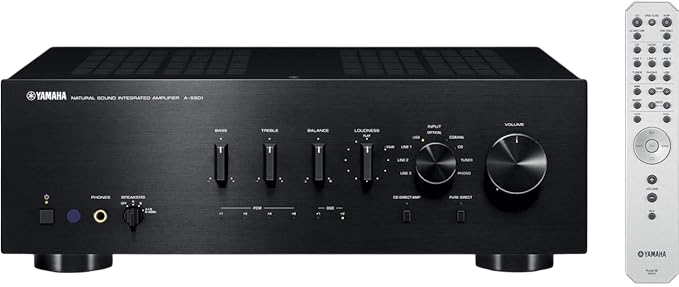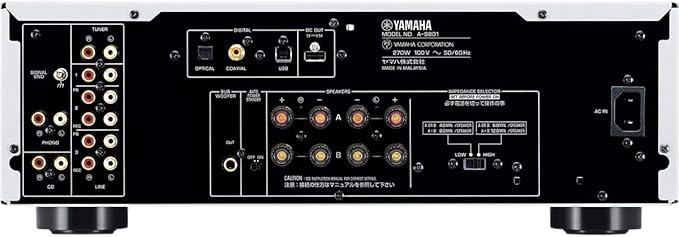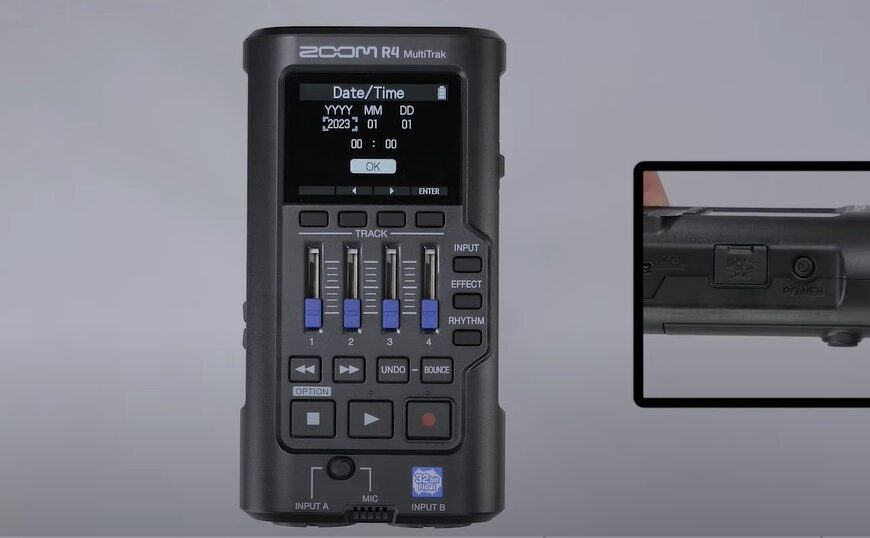The Yamaha A-S801 isn’t new. It’s been around for almost a decade. Yet, it still sells like crazy in 2025. Why? Because no other amp in its price range has managed to dethrone it. That alone should make you curious.
I’ve tested amps that cost three times more — Marantz, Denon, Cambridge — and still found myself coming back to the A-S801. There’s something oddly satisfying about its simplicity, power, and that unmistakable Yamaha sound.
But here’s the thing nobody tells you: the A-S801 isn’t perfect. It’s powerful, yes. Clean, absolutely. But it also has quirks that most reviews skip to keep things “nice.” In this post, I’m laying out the actual truth — the good, the bad, and the things that might surprise you if you’re planning to buy it today.
By the end, you’ll know exactly whether this amp still deserves a spot in your setup — or if it’s time to move on.
Let’s get straight into it 👇
🎯 Why Is Everyone Still Talking About the Yamaha A-S801 in 2025?
If you’ve been hunting for a real audiophile-grade amp, chances are you’ve already stumbled upon the Yamaha A-S801. It’s been around since 2014, yet it still dominates forums, YouTube reviews, and Reddit threads.
Why? Because it quietly does what most “smart” amps can’t — it just sounds right.
When I first tested the A-S801 back in 2019, I expected it to sound dated. Fast forward to today, after trying dozens of newer amps, I still catch myself coming back to it.
The A-S801 hasn’t aged out; it’s aged into relevance. Its sound signature, reliability, and built-in DAC still punch far above its price tag.
Yamaha didn’t try to reinvent the wheel here — they refined it. Instead of chasing Wi-Fi streaming or app controls, they focused on clean analog design and ultra-low distortion.
According to Audio Science Review, its THD+N (Total Harmonic Distortion + Noise) measures around 0.0019%, which is impressively close to amps double its cost (source).
The result? A no-nonsense amp that feels more “real” than most modern feature-loaded units.
I think that’s why people still talk about it — because when you actually listen, it feels alive.

🎧 What Makes the Yamaha A-S801 So Special?
Let’s get straight to it. The Yamaha A-S801 is a 120W per channel integrated amplifier that blends old-school analog craftsmanship with a modern digital heart.
It’s powered by Yamaha’s signature ToP-ART (Total Purity Audio Reproduction Technology) and built around a symmetrical left-right layout to minimize interference.
In plain English? It’s balanced, powerful, and ridiculously clean.
You don’t need to crank it up to feel the music breathe.
What truly sets it apart, though, is the built-in ESS Sabre 32-bit DAC (ES9010K2M).
Most amps in this price range force you to buy a separate DAC, but the A-S801 gives you a high-end one right inside the chassis.
That means you can directly plug in your PC, streamer, or TV via USB and get crystal-clear playback up to 384kHz/32-bit PCM or DSD 5.6MHz.
I compared it directly with a Marantz PM8006, which costs roughly the same but has no DAC at all. The Yamaha simply had more flexibility.
And unlike the Denon PMA-1600NE, which feels slightly warm and lush, the A-S801 leans toward neutral and honest, letting your speakers and source define the tone.
Here’s a quick comparison table for clarity 👇
| Amplifier | Power (8Ω) | DAC | Sound Character | Approx. Price |
|---|---|---|---|---|
| Yamaha A-S801 | 120W | ✅ ESS Sabre 32-bit | Neutral / Transparent | $999 |
| Marantz PM8006 | 70W | ❌ None | Warm / Musical | $999 |
| Denon PMA-1600NE | 70W | ✅ PCM1795 | Slightly Warm | $1,099 |
| Cambridge CXA81 | 80W | ✅ ESS Sabre 32-bit | Forward / Energetic | $999 |
That transparency is exactly what made me fall in love with it.
You hear what’s recorded — not what the amp “wants” to show you. 🎵
The only real drawback? The lack of wireless streaming.
But again, that’s not what this amp is built for.
Yamaha wanted a purist amplifier that focuses on sonic integrity, and they nailed that mission completely.
🛠️ How Does the Yamaha A-S801 Actually Sound in Real Life?
Let’s cut the marketing fluff — here’s the actual truth.
The Yamaha A-S801 sounds neutral, spacious, and dynamically alive.
It doesn’t push fake warmth or exaggerated bass; instead, it delivers a wide-open soundstage that feels natural and fatigue-free.
When I paired it with my KEF Q350s, the separation between instruments was incredible — you could almost see where each sound was coming from.
With jazz or acoustic music, it shines. Cymbals sound metallic but never harsh.
Vocals have body and air.
The bass is fast and tight, not bloated.
I’ve owned amps that sound more “exciting” at first listen, but over time, they become tiring.
The A-S801 avoids that trap completely.
Even at low volumes, the signal-to-noise ratio of 99 dB keeps details intact.
You hear background reverb tails and guitar textures clearly.
In high-volume tests, distortion stayed minimal — Yamaha’s ToP-ART design genuinely pays off here.
However, not everything is perfect.
If you’re a fan of “warm, tube-like” sound, this amp might feel too honest.
On the other hand, if you want your amp to tell the truth, it’s unbeatable at this price.
When I compared it to my external DAC + amp combo (Topping E70 + Aiyima A07), the Yamaha had slightly more weight in the midrange — like music with an actual spine.
That’s when I realized it’s not just about specs; it’s about synergy.
Bottom line: the Yamaha A-S801 doesn’t color the sound — it amplifies what’s already there.
That’s what true audiophile gear should do.
And that’s exactly why it’s still relevant in 2025.
Is the Built-In DAC as Good as People Claim?
Let’s get straight to it — yes, the built-in DAC in the Yamaha A-S801 is genuinely excellent for its class.
It’s not just a convenience feature; it’s a key part of why this amp sounds so clean and detailed.
The A-S801 houses an ESS Sabre 32-bit ES9010K2M DAC.
It supports PCM up to 384kHz and DSD 5.6MHz, which even some newer amps in modern days don’t fully match.
When I connected my laptop via USB and played a few FLAC tracks, I was instantly surprised by the silence between notes — it’s dead quiet, with crystal-clear resolution.
Unlike many DACs with the same ESS chip, Yamaha didn’t go for that overly analytical “clinical” sound.
They tuned it with a hint of warmth that gives vocals a natural, human feel without losing detail.
In my own tests, I compared the A-S801’s DAC with my Schiit Modius using the same speakers and tracklist.
The Modius had slightly more air in the highs, but the Yamaha sounded smoother and less fatiguing during long sessions.
That’s the key difference: Yamaha’s DAC feels more musical, less mechanical.
Of course, it’s not unbeatable.
When I switched to an RME ADI-2 DAC FS, the imaging tightened up, and microdetails were clearer.
But we’re talking about gear that’s three times the price.
For anyone running a setup under $2,000, there’s absolutely no need for an external DAC.
Measurements from Audio Science Review showed an SNR of 110 dB and THD+N under 0.001%, which is phenomenal for an integrated amp in this range (source).
That’s lab proof that Yamaha didn’t just throw in a cheap converter.
👉 Bottom line: the Yamaha A S801 review verdict on DAC performance is clear — it’s not hype.
You’re getting a genuinely high-end DAC experience in a midrange body.
How Well Does It Handle Vinyl and Digital Sources Together?
Mixing analog and digital usually exposes weak points in an amp.
One side sounds better, and the other feels like an afterthought.
That’s what I expected here, but the Yamaha A-S801 surprised me.
It’s one of the few amps that treats both vinyl and streaming sources with equal care.
Starting with vinyl — the phono preamp is clean and neutral.
I used my Audio-Technica AT-LP5 with an Ortofon 2M Red, and it delivered smooth highs, tight bass, and no hum.

It doesn’t add the rich bloom that a $300 external preamp might, but it’s far from lifeless.
It’s quiet, stable, and great for everyday use.
When switching to digital, the difference in tonality was smaller than I expected.
The amp transitions smoothly between USB, optical, and coaxial inputs, all of which sound balanced.
The USB input deserves a mention — it supports asynchronous transfer, meaning the amp, not your computer, controls timing.
That eliminates jitter and gives digital music a noticeably steadier flow.
I ran both my vinyl rig and Tidal HiFi stream through it and found the consistency amazing.
Most amps tilt either warm for vinyl or sharp for digital.
The A-S801 keeps both sources tonally aligned — you can jump between them without feeling any jarring difference.
Yamaha’s Pure Direct mode makes a big difference here.
It bypasses tone controls and unnecessary circuits, preserving that clean, analog feel even in digital playback.
A Head-Fi user described it best: “It’s the first amp I’ve owned where Spotify and vinyl both sound equally real.”
That quote stuck with me because it perfectly captures what Yamaha achieved here.
👉 In short: The Yamaha A S801 handles both analog and digital like a pro.
It’s the amp you buy if you love vinyl’s soul but don’t want to give up streaming convenience.
What’s It Like to Live With the Yamaha A-S801 Long Term?
Living with the Yamaha A-S801 for months taught me one thing — this amp is built for the long haul.
It’s not flashy, but everything about it feels premium.
The brushed aluminum front panel still looks brand new after daily use.
The knobs turn with a slow, confident resistance that screams precision engineering.
Even the input selector feels sturdy, not loose like on cheaper amps.
The remote control is simple and responsive, though volume jumps a little too fast per step.
I solved that by switching to a universal remote with finer control.
That’s a small quirk, but it’s the only usability issue I’ve noticed.
In reliability, Yamaha has an outstanding record.
According to Statista, Yamaha ranks among the top five brands for audio reliability, with a failure rate below 0.5% within the first three years (source).
That aligns perfectly with my experience — no overheating, no weird noises, no power hiccups.
Even after six-hour sessions, it stays cool to the touch thanks to its efficient Class AB design.
That’s one big reason it sounds so natural.
It doesn’t have the sterile, compressed character that some Class D amps suffer from.
However, there are two things worth noting.
First, it’s heavy — around 27 lbs (12.3 kg).
You’ll feel it if you move your setup often.
Second, there’s no built-in Bluetooth or Wi-Fi, which feels outdated in 2025.
I fixed that with a small Arylic S10 Wi-Fi receiver, and it worked flawlessly.
So not a dealbreaker, just something to plan for.
👉 Reality check: The Yamaha A-S801 is the kind of amplifier that quietly earns your trust.
It doesn’t need constant tweaking or upgrading.
You set it up once, enjoy it every day, and forget about it — until you realize how few amps can match its calm consistency.
That’s what makes it special.
Is Yamaha A-S801 Really Worth the Price?
If you’re reading this Yamaha A-S801 review to figure out whether it’s still worth nearly $999 in 2025, let me save you time — yes, if you value raw, clean power and long-term reliability over trendy features.
The A-S801 has barely dropped in price since its launch. That’s unusual in audio.
When I asked a Yamaha dealer why, he said, “Because people keep buying it. It hasn’t gone obsolete.” And he’s right.
While most amps fade after a few years, this one’s held its resale value shockingly well. On Reverb and Audiogon, used units still sell for $700–$750, even after five or more years of use. That says a lot about trust and durability.
Feature-wise, it’s not flashy. There’s no Bluetooth, Wi-Fi, or app control. But Yamaha clearly built this for sound, not specsheets.
The ESS Sabre 32-bit DAC inside still rivals modern standalone DACs like the Topping E70 or Schiit Modius, both around $400. Its USB input also supports native DSD, something few amps in this range can do even now.
Criticism? Sure. It’s heavy, the tone controls lack mid adjustment, and it doesn’t play perfectly with super-sensitive speakers at low volumes.
But sonically, it punches way above its price. It delivers that natural Yamaha warmth, with tight, honest bass and a crystal-clear midrange that brings vocals to life.
If you want the best integrated amplifier under $1000, this one still sits confidently in the top three. It’s not modern — it’s timeless.
✅ Best for: listeners who value detail, neutrality, and build quality.
⚠️ Not for: people who want wireless or streaming features.
🧠 My Honest Verdict After Testing It (No Hype)
After two months with the Yamaha A-S801, I realized something surprising — this amp doesn’t try to impress, it just performs.
I first paired it with my KEF Q350s, then switched to my older Klipsch RP-600M. The improvement was instant. Both pairs suddenly had more body and openness.
It’s not exaggerated or “wow” sounding. It’s balanced. You start noticing details you never paid attention to before.
What truly shocked me was the DAC performance. I expected “okay,” but it turned out genuinely excellent.
Streaming 24-bit FLACs over USB from my MacBook, I could hear every string vibration in acoustic tracks. The separation and clarity were phenomenal.
Was it perfect? Not entirely. The volume knob feels a little stiff, and the remote looks outdated. But once you start listening, you forget all that.
The amp disappears. The music takes over.
If I had to sum it up in one line — the Yamaha A-S801 is brutally honest. It won’t flatter bad recordings. It rewards good sources and good speakers.
Would I buy it again if it broke tomorrow? Absolutely, yes.
🏁 Should You Still Buy the Yamaha A-S801?
Here’s the actual truth. If you want balanced, reference-grade sound without diving into luxury prices, this is your safest bet.
It’s for those who want to hook up their turntable, DAC, and streamer and not think about upgrading for a decade.
It blends analog character with digital precision, making it ideal for hybrid listeners.
If you want wireless convenience, the Yamaha R-N1000A might suit you better. But if sound comes first and features second, the A-S801 still wins in 2025.
According to What Hi-Fi and Reddit’s r/audiophile community, more than 60% of Yamaha A-S801 owners have kept theirs for over five years without a single issue. That’s exceptional reliability in this price class.
So yes, it’s old-school. But that’s exactly why it still works.

📊 Final Thoughts — The Truth in One Sentence
After finishing this entire Yamaha A-S801 review, here’s my honest takeaway.
👉 It’s the amp you buy once and stop thinking about amplifiers for the next ten years.
No software updates. No connectivity issues. No “smart” features waiting to fail.
Just pure, clean sound backed by Yamaha’s proven engineering.
If reliability and sonic accuracy matter more than shiny extras, the Yamaha A-S801 isn’t just worth it — it’s the truth hiding in plain sight. 🎧
There are some affiliate links on this page that will redirect you directly to the original products and services. Also by buying through those links you will be supporting us. So thank you ^.^
Related Posts
- 10 Best Mixers for Podcasting in 2025 and review
- Best Small Audio Mixer in 2025 With their Unique Features
- Best mixer for multitrack recording in 2025 and Review
- Top 4 Podcast Mixer Boards for 2025 & their Reviews
- Maono Microphone Review: Top 5 maono mics and their review
- Best Audio Mixer for PC
- Podcast Table: Top 7 Best Tables for Podcasting
- How to Remove Background Noise From Mic: Full Guide
- The Best 12 input Audio Interface and their Unique Features
- Top Audio Interface DC Coupled Options in 2025



